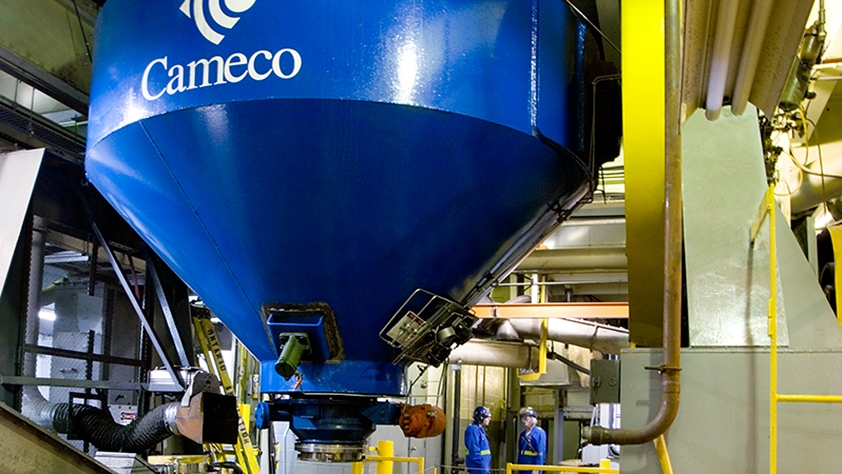Safety

Right from our facilities' designs to emergency response plans, our focus on safety is integrated into everything we do at Cameco.
Cameco's health and safety programs foster and promote a strong and sustainable safety culture.
Five key principles form the framework of how safety is managed at our operations:
- safety is our first priority;
- we are all accountable for safety;
- safety is a part of everything that we do;
- safety leadership is critical to Cameco Corporation; and
- we are a learning organization.
FACILITIES AND PROCESSES
At Cameco's Ontario operations, every employee plays a large role in safety. We are continually looking at ways to improve our processes, procedures and programs by involving employees who work directly within these environments.
A comprehensive safety analysis, which evaluates the potential hazards associated with current operational activities, is performed every five years at all sites. The analysis identifies preventive measures to be implemented, such as equipment maintenance programs, process modifications, to reduce effects of any potential hazards detected.
The safety analysis may also identify a need for changes to the physical design of equipment, processes and the facility with the potential to impact environment, radiation protection, health and safety and fire protection. Our site design controls ensure that none of those changes will have an adverse effect on the environment, the health and safety of employees or members of the public.
CONVENTIONAL SAFETY
Non-radiological safety hazards are managed through a comprehensive Occupational Health and Safety program, prescribed by Cameco's Health and Safety Management policies. Modeled on the OHSAS 18001 standard, key components of the program include:
- compliance with all safety and health-related legal and regulatory requirements;
- setting site safety and health objectives;
- implementation of corporate safety standards;
- development and maintenance of formal hazard recognition, risk assessment and change control processes; and
- documentation of health and safety significant incidents from the start through to the verification of completion of corrective actions.
RADIATION PROTECTION
Extensive radiation safety programs are in place at all Ontario fuel processing facilities to meet the requirements of the Nuclear and Safety Control Act and the Radiation Protection Regulations and ensure exposures are kept to levels as low as reasonably achievable (ALARA). The programs include:
- external dosimetry – personal monitoring;
- internal dosimetry – urine analysis and lung counting programs;
- workplace air sampling program;
- respirator program; and
- radiation and contamination surveys.
To safeguard our workers, the public and the environment, Cameco takes action on elevated results long before they reach regulatory limits. Exceedance of an action level does not pose a risk to people or the environment.
- administrative levels – a continual improvement tool, these are lower-tier internal limits established to provide very early warning of potential concern. Results above administrative levels are investigated and corrective actions taken as required.
- action levels – established well below regulatory limits, action levels serve as an early warning of conditions requiring investigation and corrective action.
- regulated effective dose limits – source: Radiation Protection Regulations
| Person | Time Period | Effective Dose (millisieverts) |
|---|---|---|
| Nuclear energy worker, including a pregnant worker | One-year dosimetry period | 50 mSv |
| Five-year dosimetry period | 100 mSv | |
| Pregnant nuclear energy worker | Balance of pregnancy | 4 mSv |
| Person who is not a nuclear energy worker | One calendar year | 1 mSv |
EMERGENCY MANAGEMENT AND RESPONSE
All of our Ontario facilities maintain comprehensive fire prevention and emergency preparedness programs. These procedures must exist for emergencies and other non-routine conditions. They are designed to protect the health and safety of employees, contractors, the public and the environment.
Working collaboratively with municipal emergency responders, each Cameco facility specially trains and equips teams of emergency responders. Frequent exercises are conducted, often with participation by local emergency responders and regulatory oversight. These drills include responses to situations such as:
- hazardous materials
- fire alarms
- medical assistance
- building evacuation
- emergency response team recalls
- a variety of emergency simulations
All drills and exercises are assessed against pre-defined expectations and opportunities for improvement are recorded and tracked to completion. Full scale emergency response exercises, including local emergency medical services and hospitals, are typically held every three to five years in Blind River and Port Hope.
PUBLIC REPORTING
Details about our safety performance are regularly reported to regulators and the general public. Additional information can be found under each of our fuel service operations’ safety pages:
